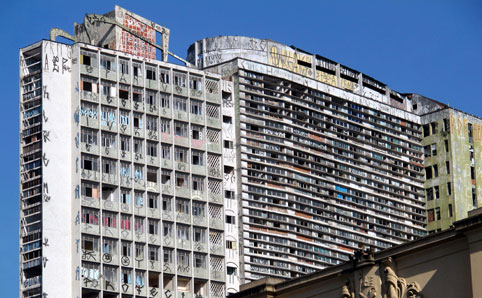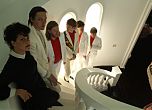
Street art’s star has risen and risen in São Paulo, to the point that it has even become, for some art lovers and collectors, a reason for visiting the city at all. Art galleries like Choque Cultural and Galeria Concreto have made a speciality of the genre, and no trip to São Paulo would be complete without a stroll through the brightly coloured gallery-in-the-wild that is Vila Madalena’s Beco do Batman alleyway. But street-art’s thoroughly paulistano sub-genre, pichação – a style of graffiti tagging that’s unique to São Paulo – is more polemical.
For the vast majority of the population, the distinctive black calligraphy is nothing more than ugly vandalism. But to a ‘picho writer’ or ‘pichador’, a building covered by it is a thing of beauty – especially if it’s the pichador’s own tags that take pride of place. For them, beauty and vandalism are malleable, debatable notions.
Pitch in
Pichação (from the verb pichar, to cover with pitch, also sometimes written as pixação), say its defenders, is the art of the poor who would rather be hated than ignored. Many of the crews who paint or spray their names onto street-level walls, or up on the heights of tall buildings, come from the favelas of the city’s periphery, or ‘quebradas’, as they call them, and leave their traces to remind the city that they exist.
Seen as a whole, the pichação that covers kilometre after kilometre of urban landscape blurs into one huge, collective piece, whose painters’ aim is to battle anonymity and social exclusion and yet stay hidden; and to externalise, in a vivid, striking way, a deeply rooted urban angst. In the documentary Pixo, which premiered in Sao Paulo during the 2009 Mostra international film festival, one of the protagonists says, ‘This art is charged with all the energy that there is in the metropolis. It’s charged with everything – egoism, perversity, the desire of the unattainable, the desire to be the best.’
Pichos emerged in the 1980s and their graphic elements are thought to have been influenced by heavy metal rock band logos. Those fonts were rooted in pagan mythology and the ancient runic alphabet – the strange, spiky glyphs used by pre-Christian Northern European peoples.
Writing on the wall
So how do you ‘read’ a picho? Alexandre Barbosa Pereira has a Ph.D. in social anthropology from the University of São Paulo, and he hung out with pichadores over a period of four years in the process of researching the subject. In an article published in 2010 in the magazine Lua Nova, he explains that a picho can contain all or any of the following elements: a grife or symbol, the name of the gang, the initials of the authors, and the year of production.
But if the São Paulo tags are considered repulsive by many, their outrage factor fascinates, and even titillates, others. In 2008, a large group of pichadores invaded the Centro Universitario Belas Artes, swarming into the building to tag walls and even artworks. Shortly afterwards, the group rushed into Pinheiros’ Choque Cultural and tagged the streetwise gallery’s walls and even some of the artworks in protest against the ‘marketing, institutionalisation and domestication of street art’. Choque Cultural is a highly respected gallery that has been credited with supporting and fomenting the activities of dozens of São Paulo artists, some of whom were formerly pichadores. Later that same year, it was the turn of the Bienal. During the offensive, the gang of some fifty pichadores was applauded by some members of the public while trying to escape from the police.
At the next Bienal in 2010, pichadores were invited to take part and given a space. And when Pixo was shown in Paris at the Fondation Cartier during a graffiti exhibition, one of the curators, overwhelmed by what he had seen, referred to the sprayed black letters as ‘what we needed – something new, wild and unknown’. And yet if the Parisian art elite was thrilled by pichação’s audacity, they would, perhaps, pale at the sight of Parisian arrondissement buildings covered in the spiky-looking pichos.



